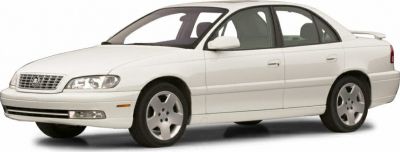 2001 Nissan Cima (F50) Dimensions, Size & Specs
2001 Nissan Cima (F50) Dimensions, Size & SpecsMeasurements of the 2001 Nissan Cima, engineered for optimal performance and comfort
| Dimensions | |
|---|---|
| Length: | 4970-4995 mm195.7-196.7 in16.3-16.4 ft |
| Width: | 1820-1845 mm71.7-72.6 in6.0-6.1 ft |
| Height: | 1450-1505 mm57.1-59.3 in4.8-4.9 ft |
| Weight Specifications | |
| Curb Weight: | 1670-1850 kg3682-4079 lbs |
| Maximal permitted Weight: | 2125 kg4685 lbs |
| Tire Specifications | |
| Tire Sizes: |
|
The Nissan Cima F50 generation, produced between 2001 and 2010, represents a prominent luxury sedan aimed at the upper echelon of Nissan's lineup. This generation brought refined styling and spacious dimensions, contributing to its role as a flagship executive vehicle. The car’s length ranges from 4970 mm to 4995 mm (195.7 to 196.9 inches), providing ample presence and cabin space. Its width varies between 1820 mm and 1845 mm (71.7 to 72.6 inches), giving the Cima a confident stance on the road, while its height ranges from 1450 mm to 1505 mm (57.1 to 59.3 inches), balancing aerodynamics with headroom comfort.
Weight-wise, the F50 Cima weighs between 1670 kg and 1850 kg (3682 to 4079 pounds) in curb weight, which reflects its solid build and luxury features, while the maximum weight can reach up to 2125 kg (4686 pounds), accounting for passengers and cargo. The vehicle uses tire sizes of 225/55 R17, 225/60 R16, or 225/60 R16 H, enhancing its ride quality and handling stability appropriate for a luxury sedan.
Designed to compete with other luxury sedans of the early 2000s, the Nissan Cima F50 emphasized comfort, technology, and smooth driving dynamics. Its generous size ensures a spacious interior for rear passengers, often a significant consideration for chauffeur-driven scenarios. Overall, the Nissan Cima F50 blends classic executive sedan proportions with the quality and performance expected from Nissan’s flagship luxury model during its production period.
Discover the standout features that make the 2001 Nissan Cima a leader in its class
Have a question? Please check our knowledgebase first.
The Nissan Cima (F50), produced from 2001 to 2010, has a length ranging between 4970 mm and 4995 mm (approximately 195.7 to 196.7 inches). This length places it solidly within the full-size sedan category, offering ample interior space and a strong road presence. The slight variation in length can depend on specific configurations or model updates during the production years.
The width of the Nissan Cima (F50) varies from 1820 mm to 1845 mm, which is about 71.7 to 72.6 inches. This width ensures a comfortable cabin for passengers, contributing to spacious seating and good shoulder room. A wider body also helps with vehicle stability and improved handling on the road.
The Nissan Cima (F50) has a height ranging from 1450 mm to 1505 mm (roughly 57.1 to 59.3 inches). This height provides a balanced sedan silhouette while ensuring generous headroom for both front and rear passengers. The height can slightly differ based on suspension setups or model variations within the production span.
The curb weight of the Nissan Cima (F50) falls between 1670 kg and 1850 kg (about 3683 to 4079 pounds). This weight range reflects its size and the inclusion of luxury features, which contribute to a solid and stable driving feel. Heavier than compact sedans, the Cima is designed for comfort and smoothness rather than sporty agility.
The maximum weight capacity of the Nissan Cima (F50) is around 2125 kg (or approximately 4686 pounds). This figure includes the vehicle's curb weight plus the weight of passengers, cargo, and any additional load. Knowing this helps in avoiding overloading, which could impact driving safety and vehicle durability.
The Nissan Cima (F50) supports several tire sizes, including 225/55 R17 and 225/60 R16. Additionally, 225/60 R16 H tires can be used. These tire dimensions balance comfort, handling, and ride quality, supporting the car's luxury sedan role. Always ensure to use the recommended tire size to maintain safety and performance.
The Nissan Cima (F50), with a length of up to 4995 mm (196.7 inches), width up to 1845 mm (72.6 inches), and height up to 1505 mm (59.3 inches), generally fits into standard residential garages. Typical garages are about 2.4 to 2.7 meters (94.5 to 106 inches) wide and around 6 meters (236 inches) deep, so the Cima should comfortably fit. However, very tight or older garages with smaller dimensions might require precise maneuvering.
Compared to its predecessor, the Nissan Cima F50 is generally larger and more refined. The previous generation had slightly shorter length and width dimensions, making the F50 notably roomier inside and offering an enhanced presence on the road. The increase in size was aimed at elevating luxury and passenger comfort while integrating advanced technologies for its time.
When compared to other luxury sedans from the early 2000s, such as the Lexus LS or the Mercedes-Benz S-Class, the Nissan Cima (F50) is competitive in dimensions. It sits within the full-size segment with a length around 5 meters and a width close to 1.85 meters. While slightly different in styling and features, the Cima offers similarly spacious interiors, solid road presence, and comfort, matching well against its peers.
The Nissan Cima (F50) is a luxury sedan produced from 2001 to 2010, known for its elegant styling and comfortable ride. It incorporates advanced technology for its era, including refined engine options, sophisticated suspension, and premium interior materials. The Cima targets buyers seeking a blend of performance and luxury, with a strong reputation in the Japanese luxury market. Its design emphasizes spaciousness, quietness, and smooth highway cruising.
Discover similar sized cars.

| Production: | 1993-1997 |
|---|---|
| Model Year: | 1993 |
| Length: | 4950-4965 mm194.9-195.5 in |
| Width: | 1796 mm70.7 in |
| Height: | 1395-1425 mm54.9-56.1 in |

| Production: | 1996-2001 |
|---|---|
| Model Year: | 1996 |
| Length: | 4945 mm194.7 in |
| Width: | 1780 mm70.1 in |
| Height: | 1435 mm56.5 in |

| Production: | 1996-2002 |
|---|---|
| Model Year: | 1997 |
| Length: | 4930 mm194.1 in |
| Width: | 1790 mm70.5 in |
| Height: | 1430 mm56.3 in |

| Production: | 2000-2003 |
|---|---|
| Model Year: | 2001 |
| Length: | 4995-5005 mm196.7-197.0 in |
| Width: | 1830 mm72.0 in |
| Height: | 1470-1490 mm57.9-58.7 in |

| Production: | 2004-2006 |
|---|---|
| Model Year: | 2004 |
| Length: | 4950 mm194.9 in |
| Width: | 1795 mm70.7 in |
| Height: | 1465 mm57.7 in |

| Production: | 2004-2006 |
|---|---|
| Model Year: | 2005 |
| Length: | 5010 mm197.2 in |
| Width: | 1850 mm72.8 in |
| Height: | 1485 mm58.5 in |

| Production: | 2007-2010 |
|---|---|
| Model Year: | 2008 |
| Length: | 5019 mm197.6 in |
| Width: | 1849 mm72.8 in |
| Height: | 1486 mm58.5 in |

| Production: | 2009-2013 |
|---|---|
| Model Year: | 2009 |
| Length: | 5003 mm197.0 in |
| Width: | 1858 mm73.1 in |
| Height: | 1503 mm59.2 in |
